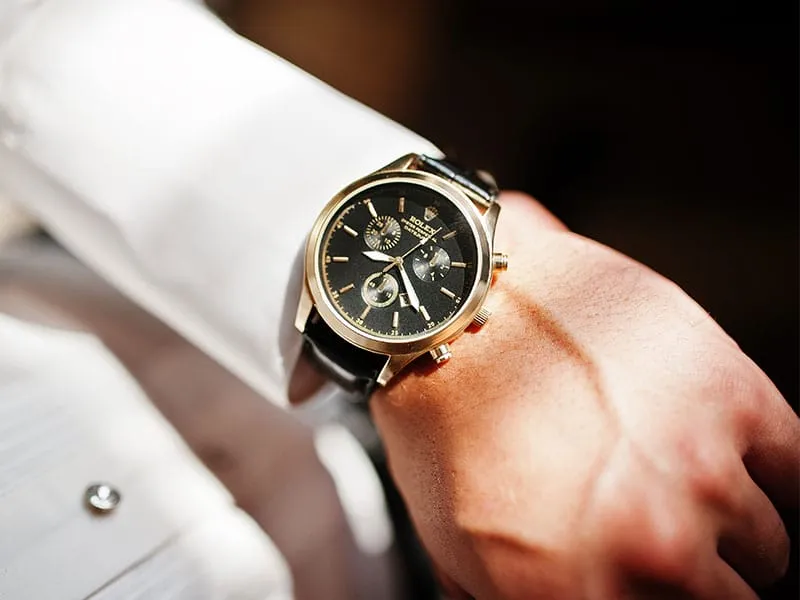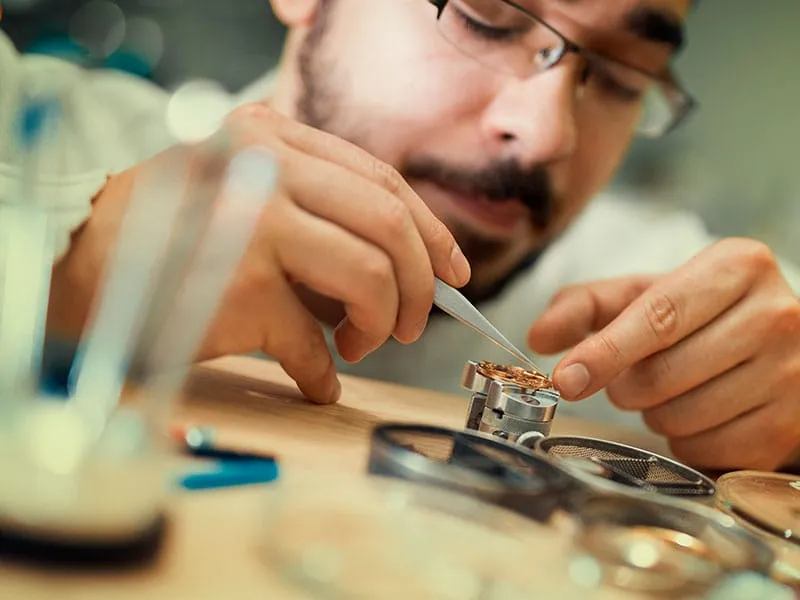
Best Quality Watches for Men & Women
Are you struggling to distinguish between high-quality and low-quality watches?
It can be challenging to recognize fine watches at first glance, but understanding the key elements of quality watches is easier than you think.
Did you know that the craftsmanship behind a high-quality watch goes beyond just telling time?
Every aspect, from the movement to the finishing, contributes to its overall value and appeal.
In this article, we’ll explore how to recognize quality watches at first glance and gain insight into the world of fine watchmaking.
Key Takeaways
- Fine watchmaking combines art and engineering, involving dedicated craftsmanship and attention to detail in every aspect from the movement to the finishing.
- High-quality watches can be identified by features such as chronometer certification, hand-finished elements, smooth second hand sweeps, and precise alignment of indicators.
- The evolution of wristwatches from simple timekeeping devices to complex pieces with complications like chronographs has raised the bar for fine watchmaking.
- When evaluating a good watch’s quality, factors like reliability, durability, accuracy, and balance between price and quality are considered essential benchmarks.
- The distinction between luxury watches (which focus on brand prestige) and fine watches (emphasizing craftsmanship) is key for buyers seeking timepieces that represent both high status and horological mastery.
Exploring the Concept of Fine Watchmaking
Fine watchmaking is an intricate blend of art and engineering, demanding a mastery that goes beyond mere timekeeping.
Craftsmen dedicate their lives to perfecting every detail, from the elegant curves of the case to the complex dance of gears within.
This pursuit marries traditional techniques with modern precision, ensuring each piece is not just a device but a testament to human ingenuity and craftsmanship.
The heart of this process lies in meticulous attention to both form and function. Every element, be it the sapphire crystal that resists scratches or the Swiss movement renowned for its reliability, plays a crucial role.
These watches aren’t simply accessories; they’re heirlooms embodying generations of skillful dedication—a reflection of personal taste as well as investment protection for those who recognize their enduring value.
With brands like Rolex GMT Master II or Audemars Piguet Royal Oak setting benchmarks, fine watchmaking emerges as both culture and craft seamlessly interwoven.

The Challenge in Distinguishing High-Quality Watches.
Identifying a truly exceptional timepiece requires an eye for detail.
High-quality watches stand out with their flawless craftsmanship and intricate watch movements, yet these features may not be immediately apparent to the casual observer.
Skilled artisans put countless hours into perfecting every component, ensuring each watch runs accurately and smoothly.
The level of finishing on even the smallest parts, like pivots and gears, separates fine watches from the run-of-the-mill.
Sifting through various brands and models to spot top-tier workmanship can seem daunting at first glance.
Look for tell-tale signs such as chronometer certification or hand-finished elements that hint at superior quality.
Discerning enthusiasts know that details like a smooth second hand sweep or precise alignment of the clock face indicators reveal much about a watch’s caliber.
Pay attention to these subtle cues; they often point towards meticulously engineered luxury watches capable of transcending generations.
The Evolution of Watchmaking
From the early days of basic timekeeping to the sophisticated craftsmanship we see today, the evolution of watchmaking is a fascinating journey that showcases human ingenuity and precision engineering.
To learn more about this historical progression and how it has shaped high-quality watches, keep reading.
A Brief History of Wristwatch Development
Wristwatches have come a long way since their inception. Initially, they were nearly exclusive to women as ornamental timepieces, while men typically used pocket watches for practical purposes.
The transition began in the early 20th century when soldiers in World War I needed an efficient way to tell time quickly and hands-free; thus, wristwatches gained popularity due to their convenience on the battlefield.
Technological advancements transformed these early models into today’s sophisticated devices. Inventions like John Harrison’s marine chronometers laid groundwork that enabled more precise timekeeping.
By the mid-1900s, mechanical watch movements dominated with intricate systems of mainsprings and gears driving pointers across watch dials.
Later on, quartz movement revolutionized the industry again by offering unparalleled accuracy through electronic oscillators regulated by quartz crystals — a technology still widely used in many modern watches such as dress watches and pilot watches alike.
The Progression From Basic Technology to Refined Craftsmanship.
Watchmaking has come a long way from the early models that did little more than tell time.
Early watches were simple, crafted with few parts and basic materials.
As technology improved, intricate watch complications like chronographs and Tourbillons entered the scene, demanding higher skill levels to create.
Craftsmen began to see their work as art, pouring countless hours into perfecting each watch’s fit and finish.
Today’s top-tier mechanical watches are a showcase of refinement, featuring automatic movements that keep time with astonishing accuracy.
Each piece reflects a dedication to perfection, from polished platinum cases to buckles designed for comfort and style.
Watch enthusiasts revel in these details—the smooth sweep of the second hand on a Rolex Daytona or the precision alignment of subdials on a Patek Philippe.
It’s this painstaking attention to detail that marks the transition from mere assembly to masterful craftsmanship in fine watchmaking.

Defining a ‘Good’ Watch
When it comes to evaluating a watch, factors such as reliability, durability, and accuracy are crucial in determining its quality.
To understand these criteria better and recognize quality watches at first glance, read more about the standards of fine watchmaking.
Criteria for Evaluating a Watch: Reliability, Durability, Accuracy.
Reliability, durability, and accuracy stand as the fundamental pillars for evaluating a watch’s quality.
Reliability ensures that the timepiece consistently operates without failure, reflecting its dependability over time.
Durability encompasses the watch’s ability to withstand external factors such as shock, water, and pressure while maintaining its functionality.
Additionally, accuracy represents the precision with which a watch keeps time, indicating its efficiency in tracking hours, minutes, and seconds.
When determining a fine-quality watch, these criteria serve as essential benchmarks for discerning superior craftsmanship and engineering.
Each element plays an integral role in defining the overall excellence of a timepiece.
The Balance Between Price and Quality.
When considering the balance between price and quality, it’s essential to weigh the value a high-quality watch offers against its cost.
A good watch should not only be reliable, durable, and accurate but also reflect the craftsmanship and materials used in its construction.
In evaluating this balance, consumers must consider their personal preferences alongside their budget, seeking out brands that offer both quality and fair pricing without compromising on performance or design.
Quality watches often strike a delicate equilibrium between premium materials, meticulous craftsmanship, and innovative technology while maintaining a reasonable price point.
This ensures that customers can invest in a timepiece that not only meets their functional needs but also provides lasting value and aesthetic appeal.
The Spectrum of Watchmaking
Differentiating between good watches and fine watches can be challenging, but understanding the subtle nuances is essential for recognizing quality timepieces.
Differentiating Between Good Watches and Fine Watches.
Good watches and fine watches may appear similar at first glance, but there are key distinctions to consider.
Good watches typically emphasize reliability, accuracy, and durability without delving deeply into craftsmanship or intricate details.
On the other hand, fine watches showcase superior craftsmanship and attention to detail, often incorporating intricate hand-finishing techniques that elevate their aesthetic appeal and technical precision.
This differentiation is essential in understanding the value and artistry behind these timepieces.
When it comes to evaluating good versus fine watches, it’s crucial to consider not only functionality but also the meticulous craftsmanship involved in creating a truly exceptional timepiece.
While good watches serve practical purposes with their reliable performance, fine watches represent a fusion of masterful artisanship and horological expertise that sets them apart as timeless pieces of enduring value in the world of watchmaking.
Examples of Brands That Offer Value and Quality.
Seiko is renowned for delivering outstanding value and quality in their timepieces.
Their commitment to precision and innovation has solidified their position as a leader in the industry.
Another notable brand, A. Lange & Söhne, exemplifies excellence through meticulous craftsmanship and attention to detail.
These brands stand out for consistently producing watches that offer exceptional value without compromising on quality.
In addition, G-Shock has established itself as a go-to choice for durable and reliable watches that cater to various lifestyles.
Each model undergoes rigorous testing to ensure longevity and performance, making it a trusted brand among watch enthusiasts worldwide.
Luxury vs. Fine Watchmaking
Understanding the distinction between luxury and fine watchmaking is essential for discerning buyers seeking to invest in quality timepieces; let’s delve into how craftsmanship, care, and time play a pivotal role in creating a true fine watch.
Understanding the Distinction Between Luxury and Fine Watchmaking.
Luxury and fine watchmaking are often used interchangeably, but they represent distinct categories within the realm of timepieces.
Luxury watches emphasize brand prestige, extravagant design, and high prices to create an aura of exclusivity.
On the other hand, fine watchmaking prioritizes intricate craftsmanship, precision engineering, and exceptional materials to deliver timeless elegance with lasting value.
The difference lies in the approach: luxury focuses on status symbols while fine watchmaking is about artistry and technical mastery.
Understanding this contrast empowers enthusiasts to make informed decisions when choosing a timepiece that aligns with their values and appreciation for horological excellence.
The Role of Care, Craft, and Time in Creating a Fine Watch.
Craftsmanship, meticulous attention to detail, and time – these are the cornerstones of creating a fine watch.
Each stage of production demands precision and patience.
The intricacies involved in assembling the components to ensure seamless functionality require an unparalleled level of care and skill.
The artistry of fine watchmaking lies in the dedication to traditional techniques combined with modern innovation.
Every element is meticulously crafted by skilled artisans, reflecting their unwavering commitment to excellence.
Time-honored methods coupled with contemporary advancements result in watches that stand as timeless testaments to human ingenuity and expertise.
The Art of Hand-Finishing
The significance of hand-finishing in fine watchmaking cannot be overstated, as it adds a level of artistry and craftsmanship that sets high-quality watches apart.

The Significance of Hand-Finishing in Fine Watchmaking
Hand-finishing in fine watchmaking holds immense significance as it epitomizes the meticulous craftsmanship and attention to detail that distinguishes exceptional timepieces.
Each intricate stroke of hand-polishing, bevelling, or engraving reflects a master artisan’s dedication to perfection, creating a unique work of art.
This personal touch not only ensures the highest level of precision but also bestows an unmistakable character upon every finished timepiece.
The careful mastery involved in hand-finishing contributes to elevating the overall quality and allure of luxury watches, captivating discerning enthusiasts with its unparalleled beauty and prestige.
The meticulous process imparts individuality to each piece, showcasing the expertise and artistry invested in its creation.
As a result, hand-finished watches stand as timeless exemplars of superior craftsmanship and artistic excellence within fine watchmaking.
Different Types of Hand-Finishing Techniques.
Hand-finishing techniques encompass a range of methods to refine the aesthetic and functional elements of a watch.
These include anglage, which involves beveling edges; perlage, creating tiny circular patterns; and Geneva stripes, producing parallel lines on metal components.
Additionally, black polishing achieves an impeccably smooth surface, and snailing adds texture with spiral patterns.
Each technique demands precision and skill, contributing to the unique character and quality of a timepiece.
Craftsmen meticulously execute these hand-finishing methods to enhance not only the appearance but also the performance of each watch.
By infusing individual artistry into every detail, these techniques elevate watches from mere timekeeping devices to works of art that capture the essence of fine watchmaking.
Standards of Fine Watchmaking

Established standards and criteria in the industry ensure that only the highest quality watches make it to market, reflecting the enduring dedication to craftsmanship.
Established Standards and Criteria in the Industry.
Industry standards and criteria for evaluating fine watchmaking involve factors like precision, reliability, durability, and craftsmanship.
These metrics help to distinguish between a good watch and a superior timepiece while providing consumers with benchmarks for making informed purchasing decisions.
For instance, the COSC certification guarantees that a watch meets precise accuracy standards, embodying an unwavering commitment to excellence in the industry.
Moreover, independent certifications such as Geneva Seal or METAS emphasize the adherence to specific quality measures set by prestigious organizations within the realm of horology.
Understanding these established standards empowers enthusiasts to appreciate the intricate workmanship behind each exemplary timepiece and recognize them at first glance.
The Importance of Finishing in Evaluating a Watch’s Quality.
Evaluating a watch’s quality is crucial, and one of the essential aspects to consider is its finishing.
The final detailing and polishing not only enhance the aesthetic appeal but also indicate the manufacturer’s commitment to precision and excellence.
When examining a timepiece, attention to details such as mirror-like polished surfaces, sharp edges without any imperfections, and intricate engravings showcases the level of craftsmanship that has gone into creating it.
Furthermore, the presence of hand-applied finishes or unique textures on components like dials or movements signifies an elevated level of artistry and individuality in each piece.
Industrial vs. Hand-Finishing
When comparing industrial production with hand-finishing, it’s important to understand the impact that hand-finishing has on a watch’s value and appeal.
To delve deeper into this topic, read more about the differences between mass-produced watches and those meticulously crafted by skilled artisans.
Comparing Industrial Production with Hand-Finishing.
Industrial production relies on automated processes and standardized methods, churning out watches in high volumes.
In contrast, hand-finishing involves meticulous craftsmanship, delivering unique and artisanal timepieces.
While industrial production ensures consistency in mass-produced watches, hand-finishing adds a personal touch and attention to detail that elevates the watch’s quality and character.
The distinctiveness of hand-finished watches sets them apart from their industrially produced counterparts, appealing to collectors seeking exceptional artistry and individuality in their timepieces.
The Impact of Hand-Finishing on a Watch’s Value and Appeal.
Hand-finishing significantly enhances a watch’s value and appeal, distinguishing it from mass-produced counterparts.
This meticulous artisanal process adds an unparalleled level of refinement and character to the timepiece, showcasing the intricate craftsmanship that goes into its creation.
By infusing each component with individual attention and skill, hand-finishing imbues a unique personality into the watch, making it more desirable to collectors and enthusiasts alike.
The exquisite detailing achieved through hand-finishing elevates the overall aesthetic of the timepiece and sets it apart as a remarkable work of art in horology.
Collectors often seek out hand-finished watches for their rarity and exclusivity, recognizing the superior quality that comes with this labor-intensive technique.
This cherished tradition preserves the legacy of fine watchmaking while ensuring that each piece is an authentic representation of exceptional craftsmanship.
The Rarity of Top-Level Hand-Finishing
Top-level hand-finishing in watchmaking is a rare art form that requires exceptional skill and expertise, making watches adorned with such craftsmanship highly coveted and valuable.
The Scarcity and Skill Required for High-Quality Hand-Finishing.
Crafting high-quality hand-finished watches demands immense skill and patience.
The scarcity of master artisans capable of executing this meticulous art form adds an extra layer of exclusivity to these timepieces.
Achieving flawless perfection in hand-finishing requires years of dedicated practice, honing the craft to embody the epitome of watchmaking excellence.
Creating exemplary hand-finished watches involves a painstaking process that encompasses intricate detailing, precision, and an unwavering commitment to preserving traditional techniques.
The Challenges and Expertise Involved in the Process.
Crafting a fine watch involves intricate precision and meticulous attention to detail.
Ensuring that each component functions flawlessly and harmoniously is no easy feat, requiring the expertise of highly skilled artisans.
The challenge lies in mastering hand-finishing techniques that elevate the watch’s aesthetics and performance to an exceptional level, demanding a deep understanding of materials, tools, and traditional craftsmanship.
Each step in the process demands unwavering patience and finesse, with artisanal skill playing a pivotal role in achieving perfection from design concept to final execution.
The challenges involved extend beyond technical mastery; they also encompass maintaining consistency across various elements while continuously evolving to meet industry standards and contemporary preferences.
Expertise in this craft becomes evident not only through refined technique but also through an intuitive grasp of artistry, allowing for innovation within the boundaries of tradition.
Identifying Hand-Finished Watches
Learn to recognize hand-finished watches by paying attention to details like polished edges, intricate engravings, and the overall smoothness of the movement.
Understanding these subtle cues can help you appreciate the craftsmanship behind fine watchmaking.
Tips for Recognizing Hand-Finished Elements in Watches.
Look for hand-polished surfaces on the watch case, bezel, and lugs. Hand-finishing often creates fine, irregular patterns known as “hand-made marks” or “Côtes de Genève,” adding a unique touch to high-quality watches.
Additionally, intricate bevels and edges that show signs of careful manual work are indicators of hand-finishing.
Finally, scrutinize the movement’s components for chamfered edges instead of sharp angles – a hallmark of meticulous hand-craftsmanship.
The Rarity of Complete Hand-Finishing in Modern Watchmaking.
Complete hand-finishing in modern watchmaking is exceedingly rare, demanding meticulous skill and artistry.
This exclusive process involves highly trained artisans dedicating hours to meticulously crafting each component by hand.
Scarcity adds a unique allure to these timepieces, emphasizing their exceptional craftsmanship and attention to detail.
The discerning eye will appreciate the labor-intensive beauty of these watches, recognizing the extraordinary dedication behind each finished piece.
Crafting such refined timepieces requires immense patience and expertise, making them highly sought after by aficionados who value traditional craftsmanship.
The intricate nature of complete hand-finishing elevates these watches into a league of their own, standing as a testament to unparalleled precision and excellence in the world of horology.
The Role of Hand-Finishing in Modern Watchmaking
The preservation of traditional hand-finishing techniques in modern watchmaking is crucial for maintaining the artistry and craftsmanship that sets fine watches apart from mass-produced timepieces.
The Preservation of Traditional Techniques.
Preserving traditional techniques in fine watchmaking is paramount to upholding the artistry and heritage of the craft.
The meticulous hand-finishing that defines high-quality timepieces has been passed down through generations, ensuring that each watch carries with it the legacy of skilled artisans.
This commitment to traditional methods not only maintains authenticity but also adds a sense of timeless value to these watches, embodying the dedication and precision synonymous with fine watchmaking.
Embracing traditional techniques serves as a testament to the enduring craftsmanship that sets apart exceptional timepieces.
By safeguarding these age-old practices, watchmakers honor their rich history while continuing to produce pieces of unparalleled quality and distinction for discerning enthusiasts worldwide.
The Relevance of Hand-Finishing in Today’s Watch Industry.
Preserving traditional techniques is paramount to understanding the relevance of hand-finishing in today’s watch industry.
Hand-finishing adds an unmistakable touch of human artistry and meticulous attention to detail, setting fine timepieces apart from their industrially produced counterparts.
In an era where skillfully crafted goods are increasingly rare, hand-finishing not only contributes to the uniqueness and individuality of each watch but also enhances its value for collectors and connoisseurs alike.
Conclusion
In conclusion, fine watchmaking is a timeless art form that combines precision, craftsmanship, and tradition to create timepieces of unparalleled quality.
If you want to learn more about recognizing and appreciating quality watches at first glance, keep reading to discover the enduring appeal and significance of hand-crafted watches in today’s modern industry.
Summarizing the Essence of Fine Watchmaking.
Fine watchmaking is characterized by exceptional craftsmanship, precision engineering, and meticulous attention to detail.
It represents the pinnacle of horological expertise, blending artistry and technical mastery to create timepieces that stand the test of time.
From hand-finishing techniques to innovative complications, fine watchmaking sets an uncompromising standard for quality and excellence in the world of luxury watches.
Each masterpiece reflects a rich heritage of tradition and innovation, offering discerning collectors an enduring symbol of sophistication and refinement.
Craftsmanship drives fine watchmaking forward, ensuring that each timepiece is not just a tool but also an expression of artistry.
The dedication to preserving age-old techniques while embracing modern advancements continues to define this industry as it evolves.
This commitment guarantees that every fine watch carries with it a legacy of unparalleled skill and timeless elegance – embodying the essence of fine watchmaking.
The Enduring Appeal and Significance of Hand-Crafted Watches.
Hand-crafted watches hold enduring appeal and significance in the world of horology.
Each meticulous detail, hand-finished with precision, speaks to the dedication and artistry of skilled watchmakers.
The personal touch and artisanal craftsmanship imbue these timepieces with a sense of uniqueness and character that is hard to replicate in mass-produced watches.
These hand-crafted watches are not just about telling time; they represent an investment in heritage, tradition, and expertise.
With their timeless allure, they serve as tangible connections to the past while also embodying a commitment to uncompromising quality that transcends trends and fads.
FAQs About Fine Watches
1. What key features should I look for in a quality watch?
Look for precise craftsmanship like on the Rolex Submariner, ensure there’s worldwide coverage such as Hodinkee Insurance offers, and check if it has unique elements like the Seiko SLA049’s specialized timer.
2. How can I tell if a watch is well-made without expert knowledge?
Examine the watchband for high-quality materials, verify the smooth movement of hands which indicates a good mechanism, and search for recognizable model numbers that denote premium watches.
3. Is there an easy way to learn about fine watches?
Yes, join mailing lists from reputable watch sellers or enthusiasts’ groups; they send information straight to your inbox about luxury timepieces and how to identify top models.
4. What’s special about kinetic watches compared to other types?
Kinetic watches harness energy from your movements; this modern innovation powers the timekeeping functions efficiently with fewer interchangeable parts needed over time.
5. Can insurance protect my investment in a luxury watch?
Absolutely! Investing in comprehensive policies like those offered by Hodinkee Insurance helps cover repairs or losses with benefits like zero deductible options for peace of mind.




